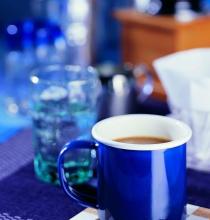A brief introduction to the treatment method of grinding and baking degree of Indonesian West Java boutique coffee beans with low acidity

By the 18th century, Indonesia had become a major producer of coffee, supplying almost all of its high-quality Arabica coffee to Europe. But in the 19th century, coffee rust, which appeared in Ceylon as early as 1869, also affected Indonesia. By 1877, most of the coffee fields on the Indonesian islands had been destroyed by rust, and the Dutch had to import another coffee variety from Africa, namely Romstar coffee. It is more resistant to pests and diseases, but the quality is inferior. About 90% of Indonesian coffee is made up of Romstar beans, about 6.8 million bags a year, and less than 10% of beans are Arabica coffee.
Coffee produced in Indonesia is generally not crowned with the name "Indonesia", but directly with the island name, such as Java, Sumatra, etc.
Later brought to Jamaica by the British. By 1925, coffee cultivation had become a tradition in Central and South America. That same year, coffee was grown in Hawaii, the only coffee producer in the United States, and Hawaiian coffee is one of the best in the world.
At present, 90% of coffee beans exported from Indonesia are Robusta beans and only 10% are Arabica beans. Before 1920, due to a major environmental disaster, Indonesia's coffee varieties were replaced by Robusta beans. Therefore, Sumatra's Mantenin coffee is a rare Arabica bean, which is a treasure before the discovery of Blue Mountain. The Dutch first introduced coffee to Central and South America in the 1820s. Coffee spread from Dutch colonies to Guyane française and Brazil, and the Dutch, in the course of their colonization, planted coffee in Malaba, India, and brought coffee to what is now Batavia, Indonesia, in 1699. The Dutch colonies were once the main suppliers of coffee to Europe. Indonesia is currently the fourth largest coffee exporter in the world and Indonesia was the first colony to start growing coffee trees. Indonesia's archipelago is the world's largest producer of Robusta beans. This is called high-quality Arabica beans, such as Java and Sumatra.
Java: coffee bean species-Robusta
Sumatra: coffee bean species-Arabica
Java coffee beans (coffee powder) belong to: Robasta (Robusta) varieties, mainly distributed in African countries such as Cote d'Ivoire, Angola, Madagascar, etc. and the Philippines, Vietnam and Indonesia (Java) and other places.
Java coffee growing environment and main producing areas
Robusta is cultivated in lowlands, resistant to high temperature, drought, rain, pests, adaptability is very strong, can grow very well in the flat, harvest does not necessarily need artificial, can be completely carried out with vibration machines.
Robusta coffee, which is commonly used in blending, has two main types: A. P. Robusta and W.I.B.Robusta.
Except for W. I. B., the particles are larger, and the other particles are smaller. The biggest difference lies in the processing after harvest, so there are certain differences in appearance, aroma and taste.
Java Coffee-Culture
Java coffee beans early years of Java coffee fame, here refers to the former Java produced Arabica coffee. It has a rich aroma, low acidity, smooth taste, and with mocha coffee, the result is "Java mocha blend coffee" once popular, synonymous with top coffee, fame spread.
Java coffee sold to Europe at that time was a very special coffee. Because it was shipped to European and American countries by sailboat at that time, the journey was long and the speed was slow, so it took a lot of time on the way. Coffee in this case, as if after a special fermentation, taste very unique.
Later, when ships replaced sailboats, people drank fresher coffee beans because of shorter delivery times. But people accustomed to old beans are not used to this fresh taste, so they desperately pursue old Java coffee, so that the Indonesian government and some businessmen deliberately store fresh beans in warehouses for one to two years before selling them to consumers. In fact, the acidity of aged Java beans is reduced to nearly zero compared to fresh beans, while the aroma is more intense. Because of the long storage time, the cost increases a lot, and the quantity is limited, so aged Java has always been a hot commodity in the coffee market. In the 1880s, some traders deliberately tampered with fresh Guatemala or Venezuela beans to copy old Java and sell them at high prices. What is intolerable is that 0 traders dye coffee beans in a way that makes them look more like aged java, but there is no doubt that the dyeing chemicals are poisonous.
Java produces only a small number of arabica beans, most of which are Romstar beans imported from Africa after the rust disaster. The roasted coffee has a strong bitter taste but an extremely light aroma. Although it has a low acidity and a delicate taste, it is rarely used as a direct drink. It is often used to blend coffee or to make instant coffee. Java coffee is produced in Java, Indonesia. It belongs to Arabica coffee. After baking, the bitter taste is very strong and the fragrance is very light, without sourness. Java coffee bitter, alcohol, coupled with the sweet chocolate syrup, Java coffee more mellow smooth, very popular with women!
Among the coffee-producing Asian countries, Indonesia is one of the most noteworthy. Indonesia is an island country in the Indian Ocean, with islands on both sides of the equator, three of which: Java, Sumatra and Sulawesi produce globally important coffee. In the mid-17th century, the Dutch brought coffee trees to Ceylon (Sri Lanka) and Java in Indonesia.
Important Notice :
前街咖啡 FrontStreet Coffee has moved to new addredd:
FrontStreet Coffee Address: 315,Donghua East Road,GuangZhou
Tel:020 38364473
- Prev

A brief introduction to the cultivation of boutique coffee beans in West Java, Indonesia, geographical location, climate and altitude
At present, 90% of the coffee beans exported from Indonesia are Robusta beans, and only 10% are Arabica. Before 1920, due to a major environmental disaster, Indonesian coffee varieties were replaced with Robusta beans, so Mandarin coffee in Sumatra is a rare Arabica bean, a treasure before it was discovered in the Blue Mountains. The output of such authentic products is also very small.
- Next

A brief introduction to the description of flavor, taste and aroma characteristics of Guatemalan boutique coffee beans with balanced acidity
Antigua is a famous producer of coffee. Antigua coffee is produced in Hacienda Carmona, where the best quality coffee is EL Pulcal, which is not only of good quality, but also has a stronger flavor, richer taste and stronger tobacco flavor than other Guatemalan coffee. The area near Antigua is hit by a volcano every 30 years or so.
Related
- Detailed explanation of Jadeite planting Land in Panamanian Jadeite Manor introduction to the grading system of Jadeite competitive bidding, Red bid, Green bid and Rose Summer
- Story of Coffee planting in Brenka region of Costa Rica Stonehenge Manor anaerobic heavy honey treatment of flavor mouth
- What's on the barrel of Blue Mountain Coffee beans?
- Can American coffee also pull flowers? How to use hot American style to pull out a good-looking pattern?
- Can you make a cold extract with coffee beans? What is the right proportion for cold-extracted coffee formula?
- Indonesian PWN Gold Mandrine Coffee Origin Features Flavor How to Chong? Mandolin coffee is American.
- A brief introduction to the flavor characteristics of Brazilian yellow bourbon coffee beans
- What is the effect of different water quality on the flavor of cold-extracted coffee? What kind of water is best for brewing coffee?
- Why do you think of Rose Summer whenever you mention Panamanian coffee?
- Introduction to the characteristics of authentic blue mountain coffee bean producing areas? What is the CIB Coffee Authority in Jamaica?

